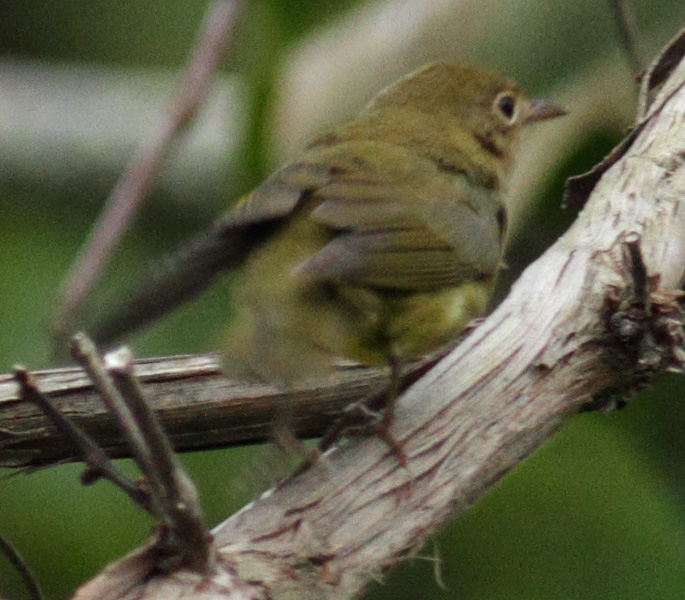
Probable Connecticut Warbler
WOW, WOW, and another WOW! I never expected that this morning's hike on the trail would be my biggest birding day ever in terms of number of species seen in a single day, which ended up at either 49 or 50. In addition, my highest priority birding goal is to photograph all 36 of the central Virginia warblers (there are a few other warbler species that have been reported in parts of Virginia, but are very rarely seen in this area). I still needed three more warbler species to complete this goal: Connecticut being the rarest, Mourning, and Bay-breasted, the last being the easiest of the three to find. A couple of days ago I told one of my birding pals, Walt Childs, that I had a feeling that the Bay-breasted, and not the Connecticut, would be my #36. This morning I photographed probable Connecticut and Mourning Warblers.
The sky was completely overcast with patchy fog, and the forecast was for heavy rain starting later in the day and continuing through the next day. As I write this posting (on the 18th), there is heavy rain outside. I arrived at the trail at 8:30 a.m. and parked a short distance north of the first wooden bridge on the Glenthorne Loop trail, and my plan was to hike down the east side of Reids Creek about half a mile to the second wooden bridge, just as I had done during the past week when I saw great birds such as Blue-winged and Lawrence's Warblers that are shown in earlier blog postings. Because of the dark skies, I had to set my camera to high ISO values resulting in somewhat grainy images. I can do a lot of processing to remove some of the image noise, but wanted to get this posting out as soon as possible, so please excuse the less than perfect photos.
By the time I almost reached the second wooden bridge in about 45 minutes, I thought I had 32 species, and it was starting to drizzle. In reality, I had 30 or 31 species, as I thought that I had a quick look at the Yellow-throated Vireo that has been in that area, but my photo looks like it was one of the White-eyed Vireos that have been singing there. The other unknown is whether I saw a Hooded Warbler or a Wilson's Warbler, or both species, and this is discussed later.
I walked quickly back to my car trying to keep my camera dry as best I could, so that I wouldn't be caught in a heavy downpour. By the time I reached my car, the drizzle had almost stopped, and I decided to try that hike a second time, and this time I crossed the second wooden bridge, hiked north along the west side of Reids Creek and around the bog area to halfway down the downstream trail, and then back to the first wooden bridge. On this second leg of my trip, I added 15 more species. There were lots of Ruby-throated Hummingbirds at the edges of the bog area, and one of them flew right up to me and hovered about six inches in front of my camera lens for almost a minute - much too close for my lens to focus on it - perhaps it saw its reflection in the lens.
Well, it had been two hours and I thought I had 46 species at this point. I crossed the first wooden bridge to the east side of Reids Creek, looked at my car to the north, and then looked down the trail to the south, and although my legs were already tired from hiking about three to four miles, my brain was too pumped, and I made a third trip to and past the second wooden bridge. At the very end of the Glenthorne Loop trail, about 50 feet past the second wooden bridge, there is a lot of brushy vegetation - I saw a bird about two feet off the ground, and got off a couple of photos before it jumped down into the brush - it was a Mourning Warbler! A couple of minutes later a bird popped up out of the brush, and I got a lot of photos of it, but this bird was most likely a Wilson's Warbler, and not the Mourning Warbler.
Before concluding that one of the warblers I photographed was a rare Connecticut Warbler, I wanted to rule all other possibilites. Warblers in their non-breeding/fall plumages can often be confusing to identify because of similar appearances. Other warblers that might be confused with a Connecticut include Nashville, Mourning, Macgillivray's, Common Yellowthroat, and Yellow. Macgillivray's is a western U.S. warbler and can be eliminated as a possibilty.
The warbler was sitting on a low branch of a fallen tree about three feet off the ground. It sat there for a long time while I took 19 photos of it in a little over 20 seconds before it got spooked by me and flew away. First take a look at some of the photos, and then I will return to discussing the identification.

Probable Connecticut Warbler

Probable Connecticut Warbler
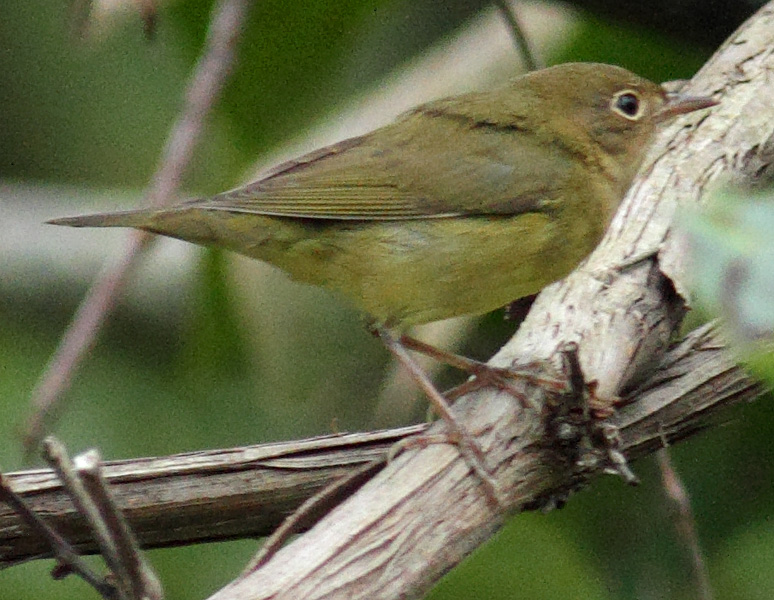
Probable Connecticut Warbler
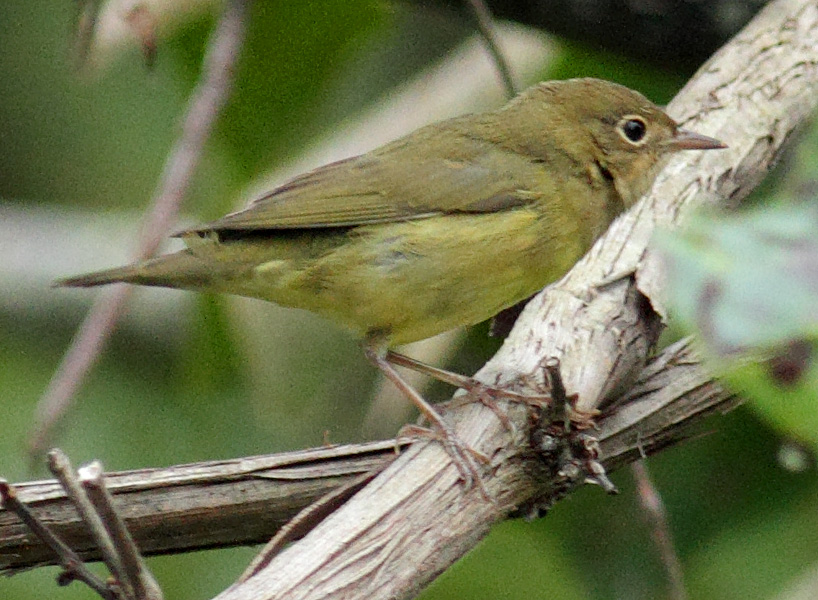
Probable Connecticut Warbler
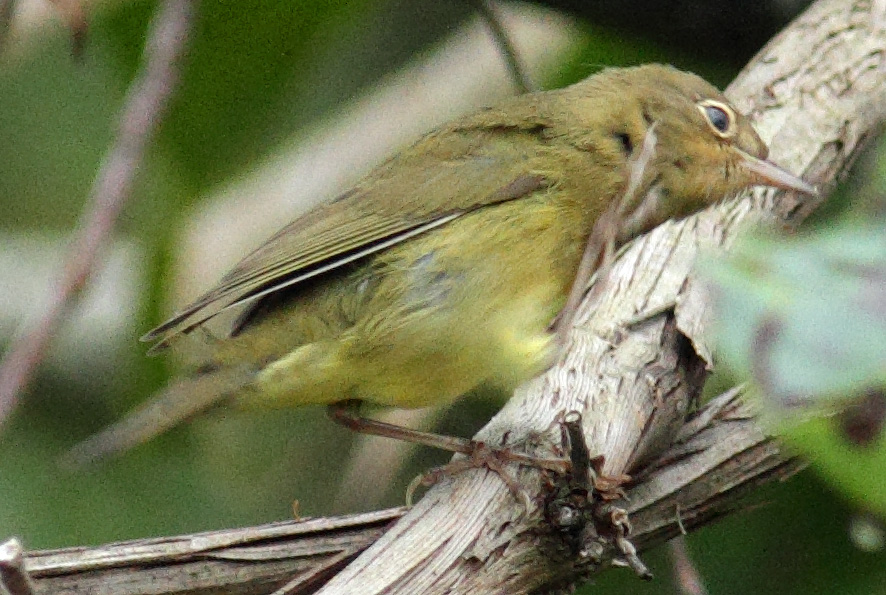
Probable Connecticut Warbler

Probable Connecticut Warbler
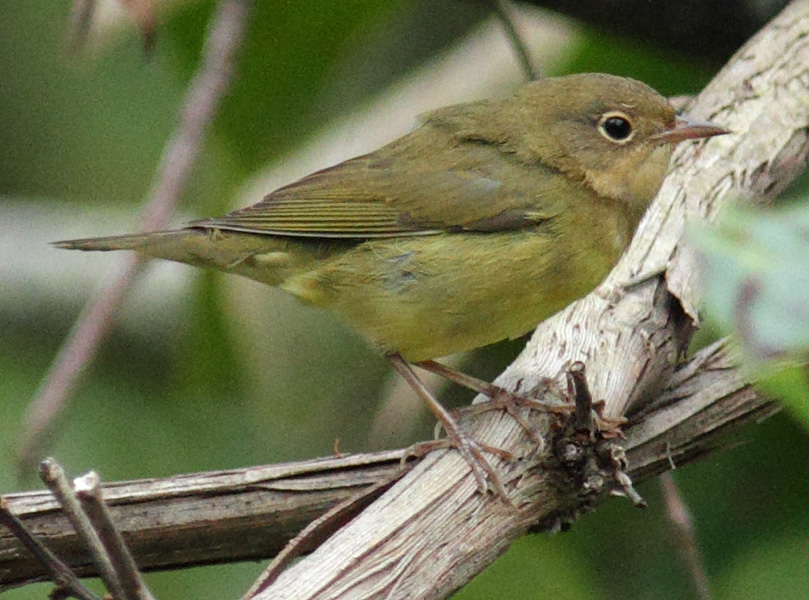
Probable Connecticut Warbler
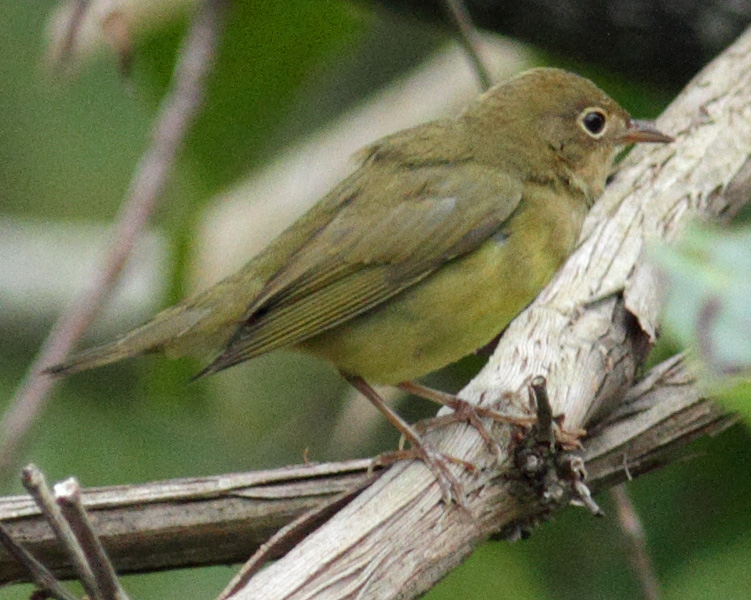
Probable Connecticut Warbler
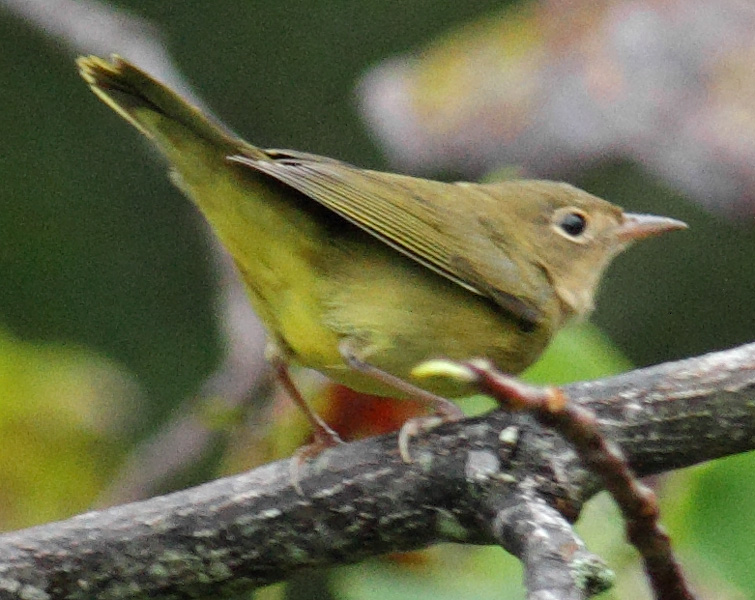
Probable Connecticut Warbler
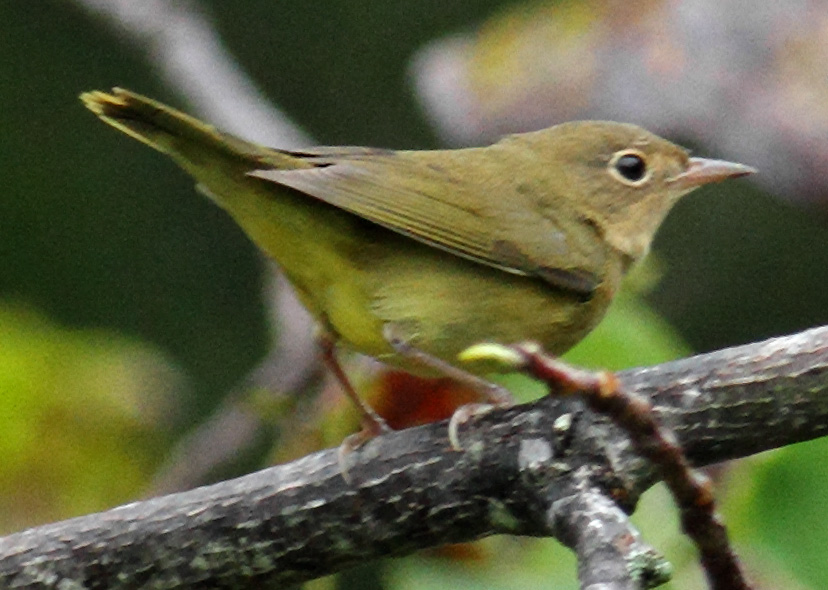
Probable Connecticut Warbler
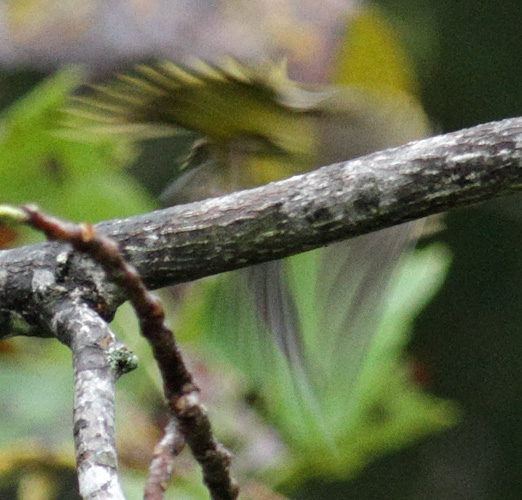
Probable Connecticut Warbler
Connecticut Warblers prefer low, dense vegetation, and will often sit thrush-like on a branch for an extended period. So the location and its posing for me are consistent with Connecticut behavior. These warblers are olive above and pale or dull yellow below, have a bold white or buffy eye ring, and a gray or brown hood. First fall females have buffier throats. So far, so good.
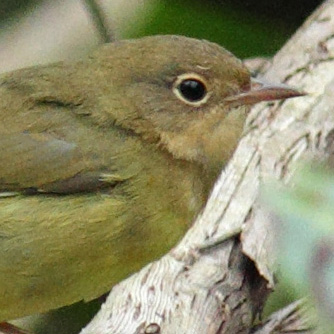
Olive above and dull yellow below, buffy throat, brown hood, and bold eye ring
The bill on a Connecticut Warbler is fairly heavy, has a brown tip, and the lower mandible and sides of the upper mandible are pinkish.
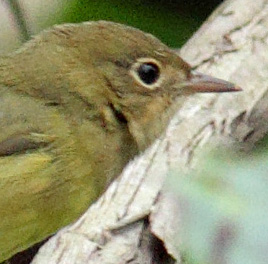
Fairly heavy, pinkish bill with a brown tip
Now I want to eliminate the other possible warbler species. The Mourning Warbler usually has a split, thin eye-ring, and the bird I saw does not. Mourning Warblers usually have a grayish hood and much yellower underside, so I think that Mourning Warbler can be eliminated.
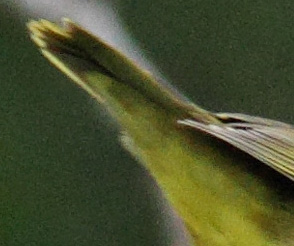
Undertail coverts
That leaves Nashville, Common Yellowthroat, and Yellow. Now consider the undertail coverts. This bird has yellow undertail coverts that extend far down the tail, and the tail tips are dark olive. Peterson's (Dunn and Garrett) warbler guide shows comparisons on warbler undertails, and the only similar ones to the Connecticut are:

Undertails
This bird is definitely not a Kentucky Warbler, and the undertails do not match Common Yellowthroat or Yellow. That leaves only the Connecticut that has not been eliminated. But I still had a nagging concern. Some fall Yellow Warblers can be olive brown with white eye rings. Take a look at a Yellow Warbler I photographed on the trail a couple of years ago. Yellow Warblers also have yellow spots on the five outer retrices (tail feathers) of their six pairs of retrices.
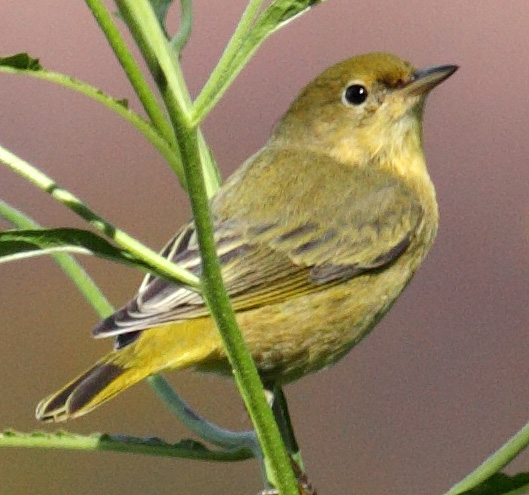
Yellow Warbler
The probable Connecticut Warbler shows yellow on the ends of all of its tail feathers as it flew away. But as can be seen when its tail feathers were closed, the outer ones appear yellow, and I think that it is just light passing through the feathers, and all, including the inner pair of retrices are yellow, and not just on the outer five pairs. Furthermore, the closed undertail pattern of the Yellow Warbler does not match, and the bright tertial fringes of the Yellow Warbler are not seen on the probable Connecticut.
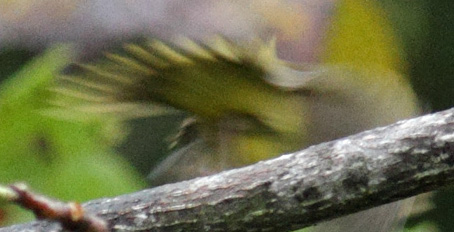
Yellow tail highlights

Undertail coverts
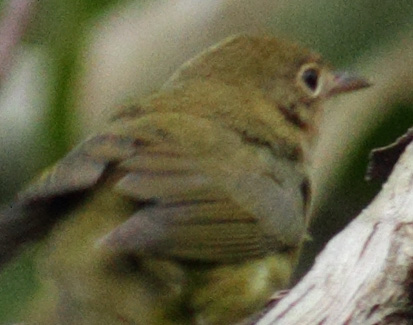
Probable Connecticut Warbler tertial edges
I think that I have eliminated all of the other possible warblers, and this bird is probably a Connecticut Warbler, but I would appreciate opinions from those who are more familiar with thus species.
At the south end of Reids Creek (east side), past the second wooden bridge, I got couple of photos of a probable Mourning Warbler. I wish that I had additional photos, but it jumped down into the dense vegetation, and a different bird popped up a minute later that got my attention. This bird might be an Orange-crowned Warbler, but I think that the gray cap makes it a Mourning. Two other birders, Vic Laubach and Gabriel Mapel, visited the trail later in the day after reading my alerts, and also saw a photographed a Mourning Warbler in the same location. Again, opinions are welcomed.
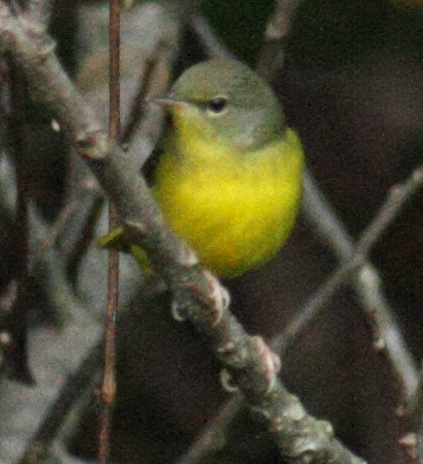
Probable Mourning Warbler
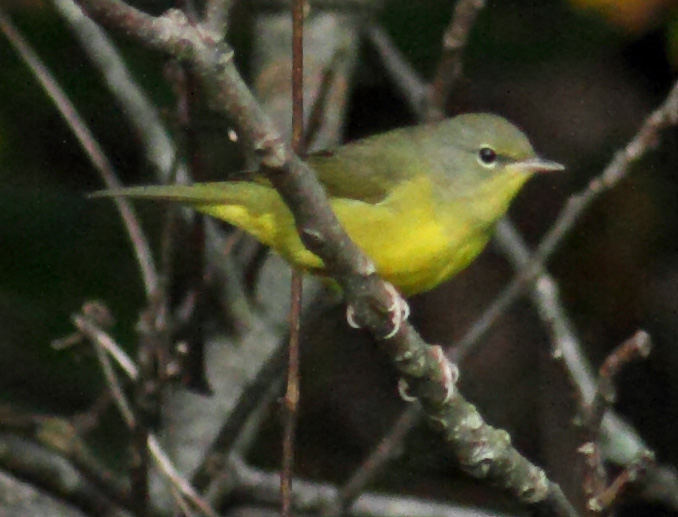
Probable Mourning Warbler
As if the Connecticut and Morning Warbler identifications weren't difficult enough, I photographed three birds that have characteristics of both Wilson's and Hooded Warblers. It might help to first take a look at the undertails of both species:
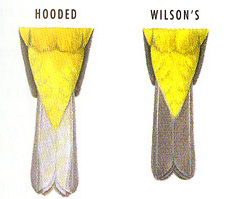
Wilson's and Hooded Warbler undertails
The Wilson's undertail has no white in it, but the Hooded undertail has a lot of white. The first two Wilson's/Hooded Warblers I saw were on my first trip down Reids Creek, and in the field, I thought that I had two different warbler species. However, when looking at the photos afterwards, I think that they are the same species. Except for the dark lores found on Hooded Warblers, they look like Wilson's warblers to me; however, one of the birds appears to have a lot of white in its undertail making one or both of them Hooded Warblers.
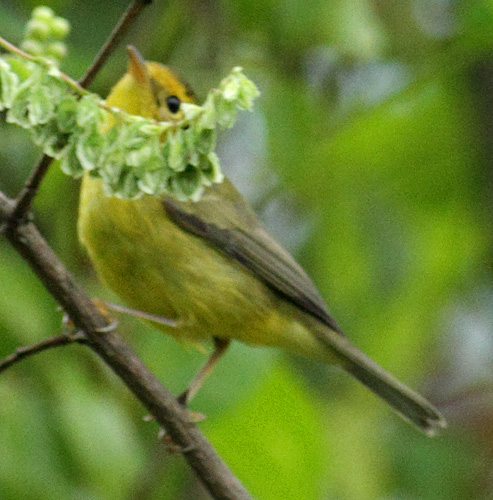
Hooded(?) Warbler
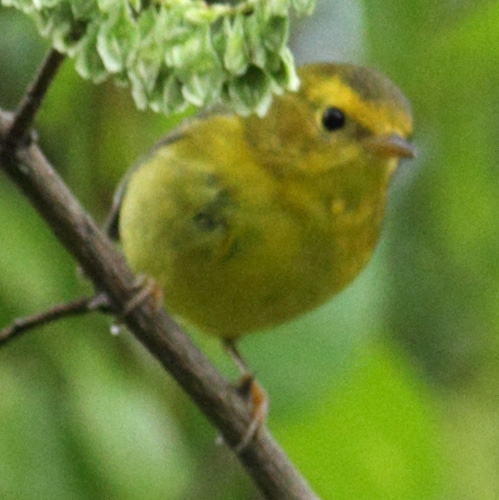
Hooded(?) Warbler
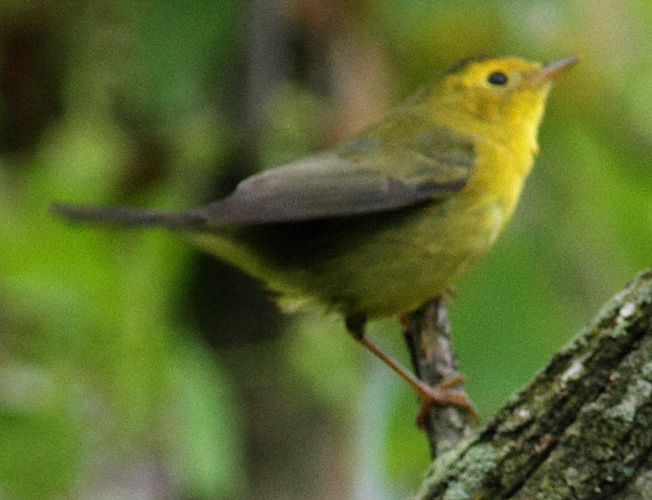
Hooded(?) Warbler

Hooded(?) Warbler
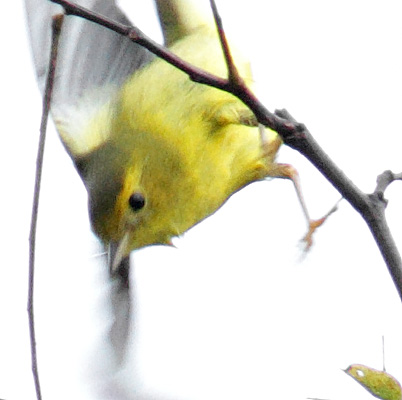
Hooded(?) Warbler

Hooded(?) Warbler
To make matters even more confusing, the bird that popped out of the brush right after I saw the Mourning Warbler looks just like the first two Wilson's/Hooded Warblers, except that this bird definitely has the undertail of a Wilson's Warbler. Vic Laubach and Gabriel Mapel reported seeing a Hooded Warbler on the trail, but not a Wilson's.
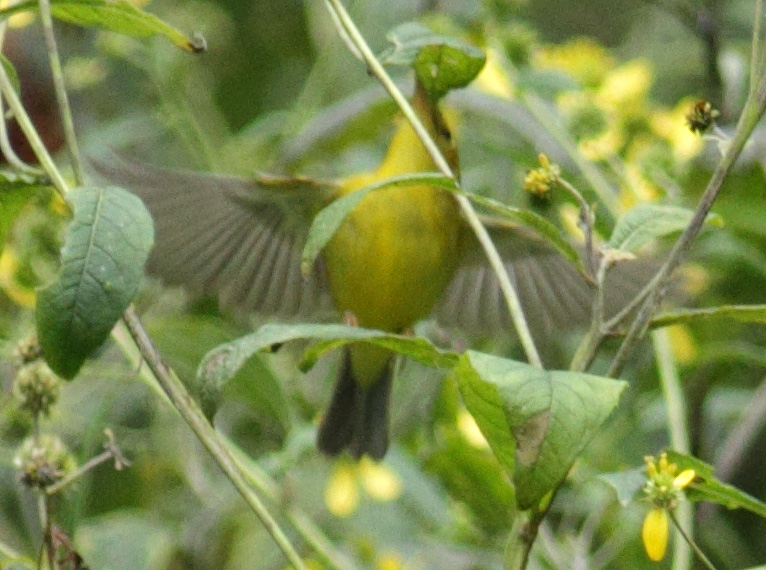
Wilson's(?) Warbler
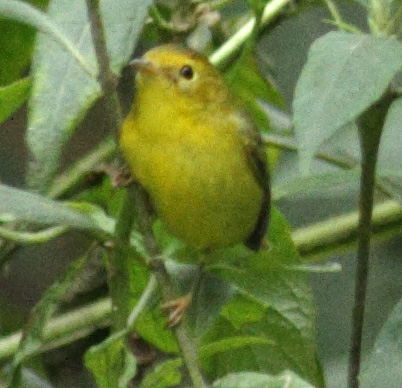
Wilson's(?) Warbler

Wilson's(?) Warbler
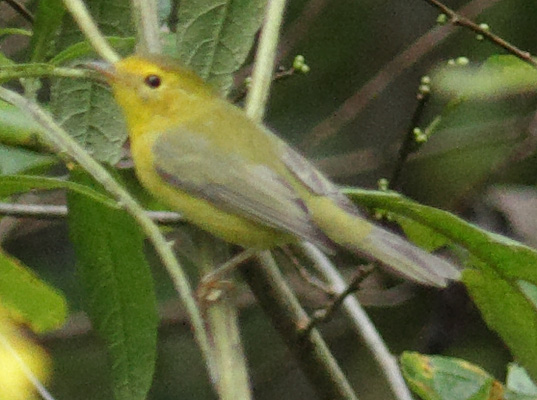
Wilson's(?) Warbler
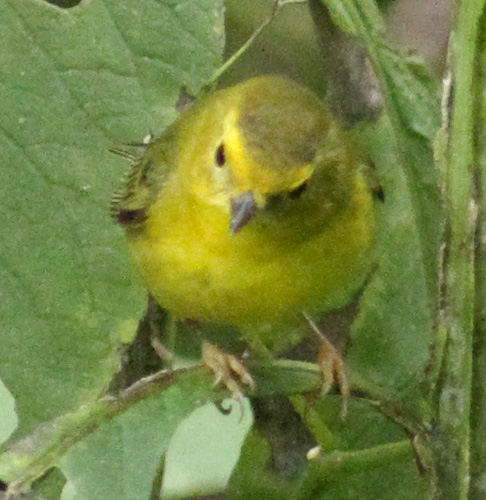
Wilson's(?) Warbler
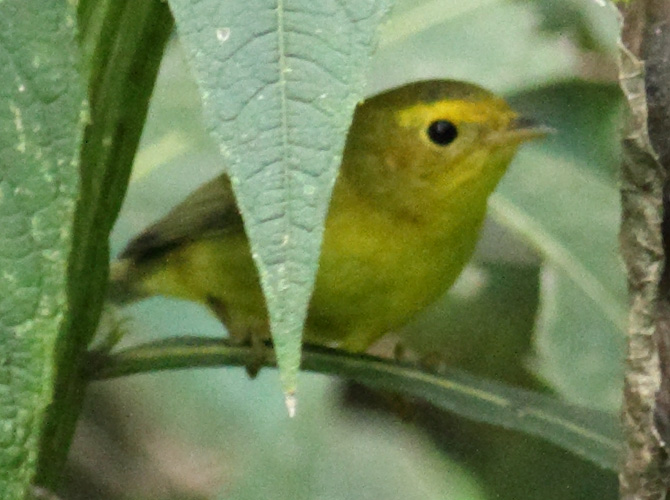
Wilson's(?) Warbler
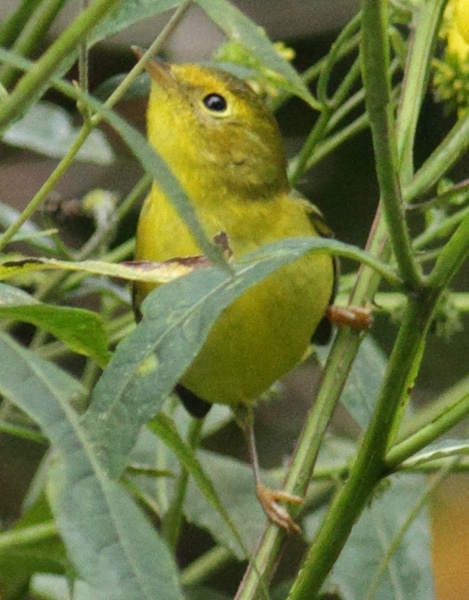
Wilson's(?) Warbler
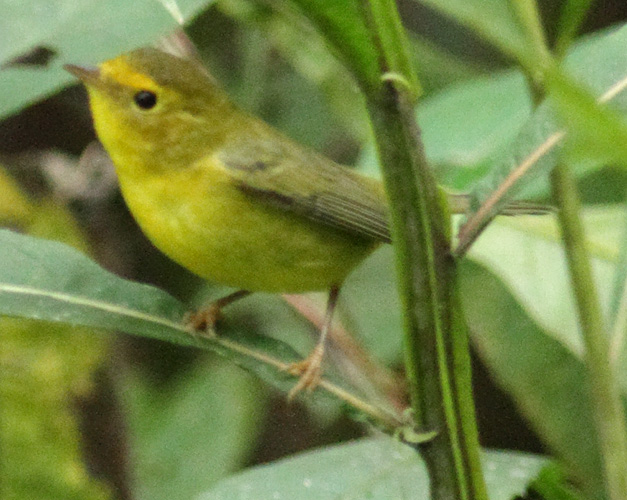
Wilson's(?) Warbler
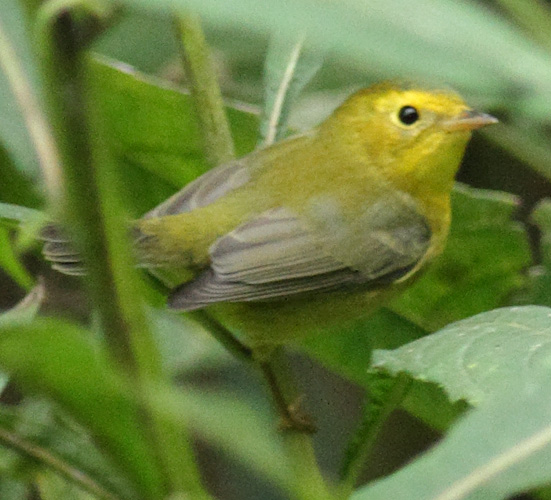
Wilson's(?) Warbler
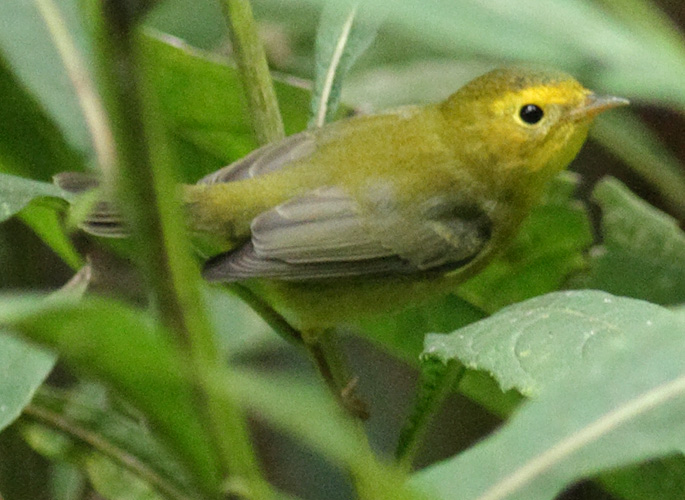
Wilson's(?) Warbler
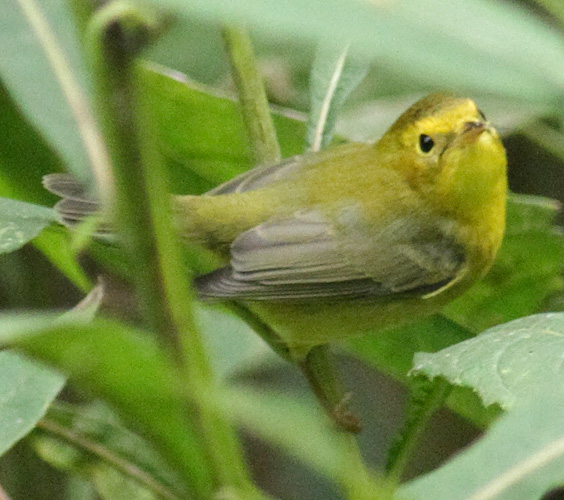
Wilson's(?) Warbler
The only conclusion that I can draw from these photos is that the one photo showing white in the undertail is really not white, but a lighter gray feather, and the dark lores can be seen on a Wilson's Warbler, and all three birds are Wilson's. Opinions?
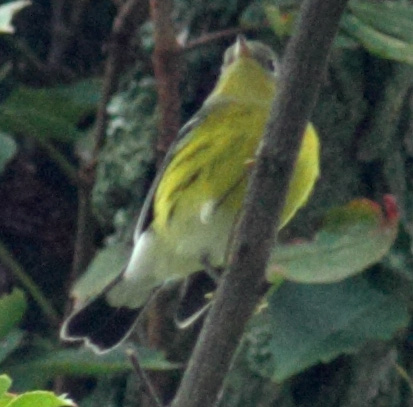
Magnolia Warbler
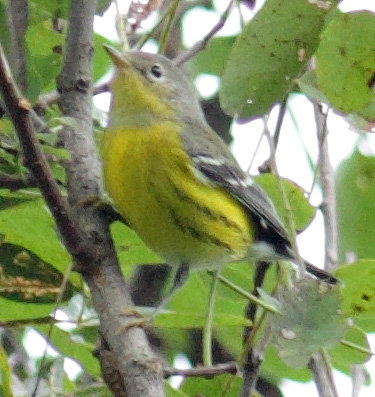
Magnolia Warbler
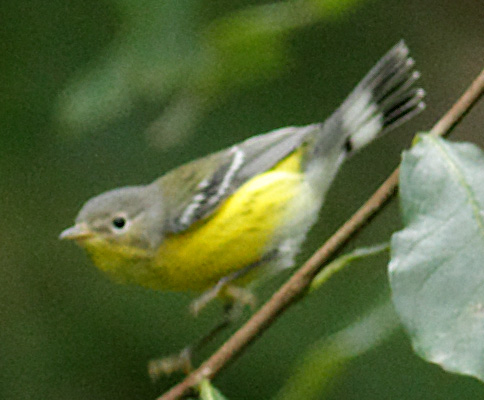
Magnolia Warbler
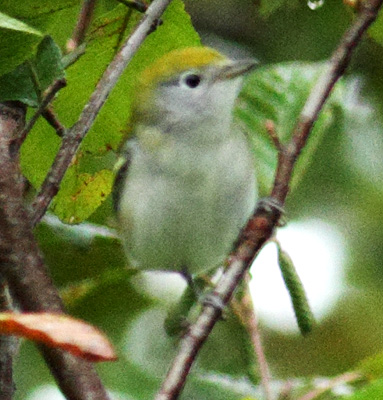
Chestnut-sided Warbler

Black and White Warbler
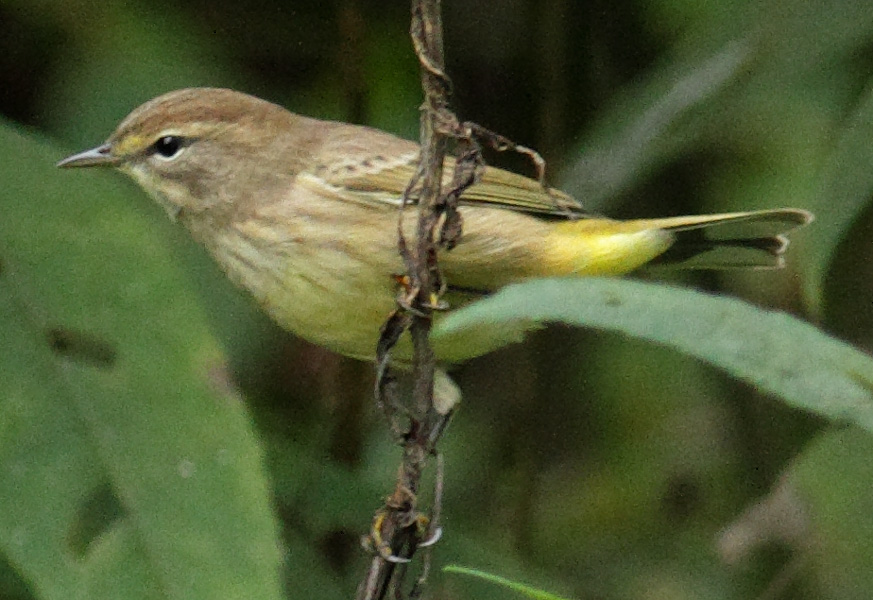
Palm Warbler
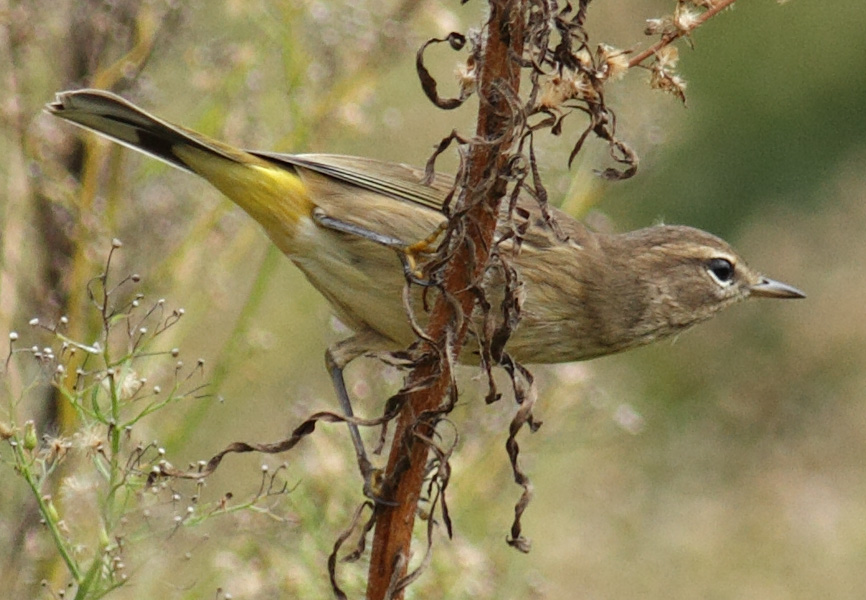
Palm Warbler
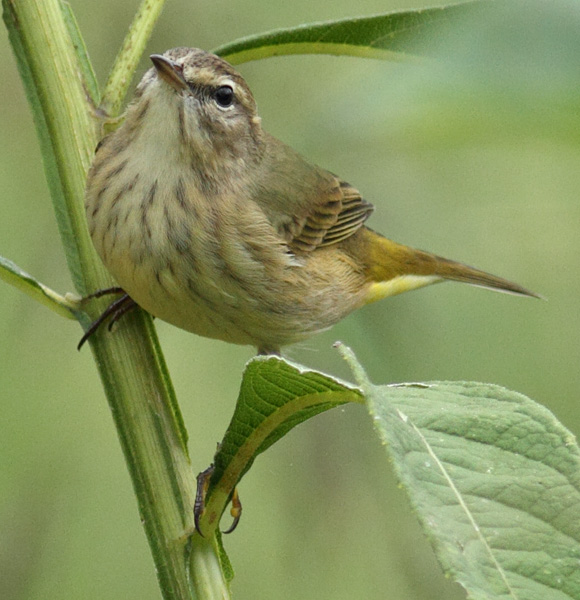
Palm Warbler

Palm Warbler
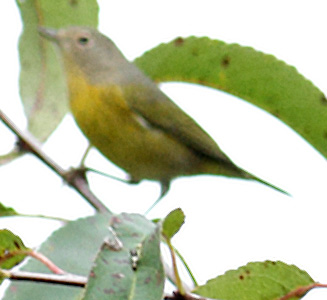
Nashville Warbler
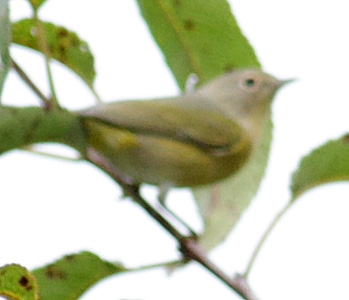
Nashville Warbler
There were far too many species seen today to show all of them. A probable Red-eyed Vireo seems to have too short of a bill and too little of a white eye-brow to be a Red-eyed, but I don't know what else it could be.
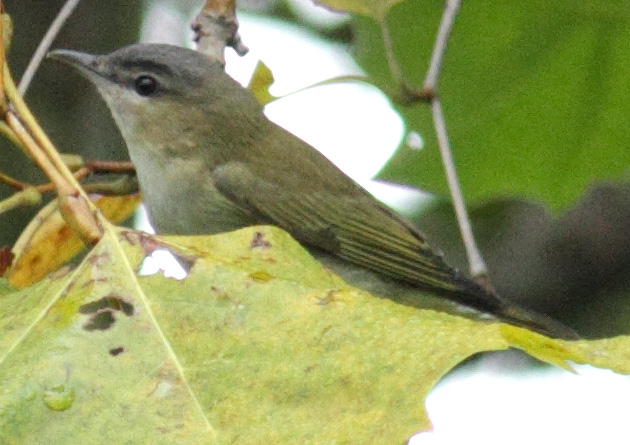
Red-eyed Vireo
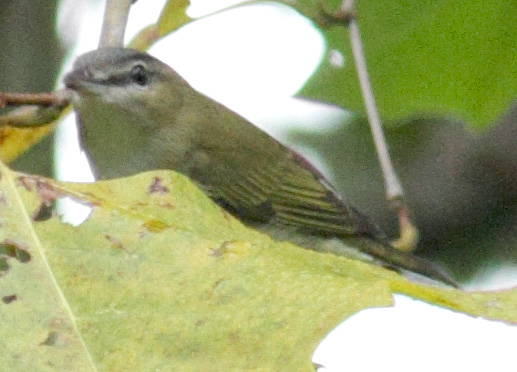
Red-eyed Vireo
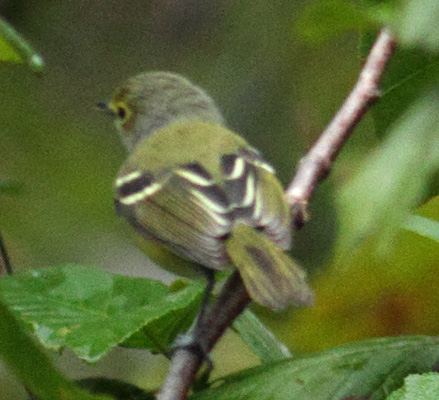
White-eyed Vireo
I saw the rare Olive-sided Flycatcher at the top of a dead tree branch about half way down the downstream trail, and again at the top of a tree just on the west side of the first wooden bridge on Glenthorne Loop. As if to reassure any "doubting Thomases," the OS Flycatcher turned around so that I could photograph its white rump patches.
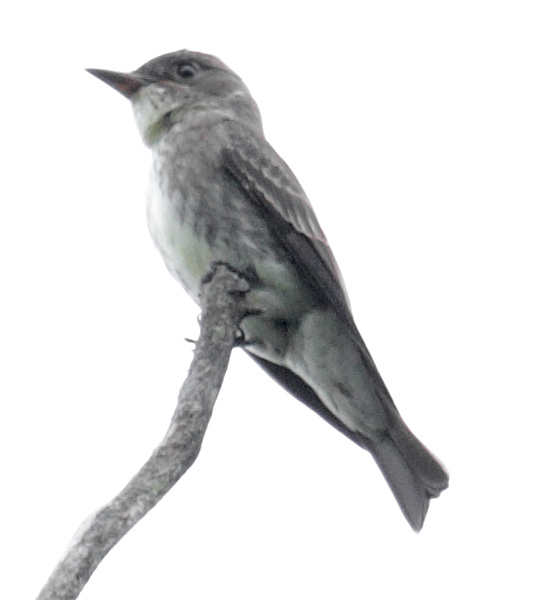
Olive-sided Flycatcher
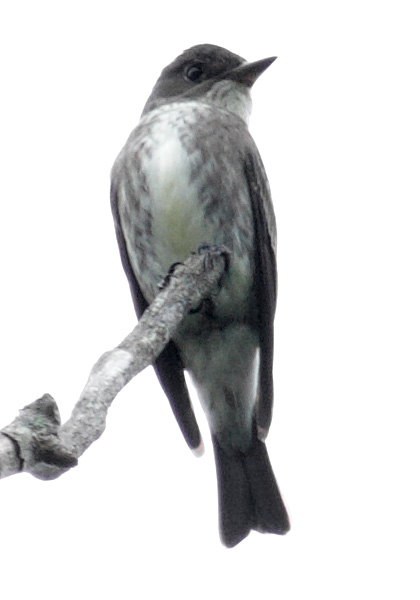
Olive-sided Flycatcher
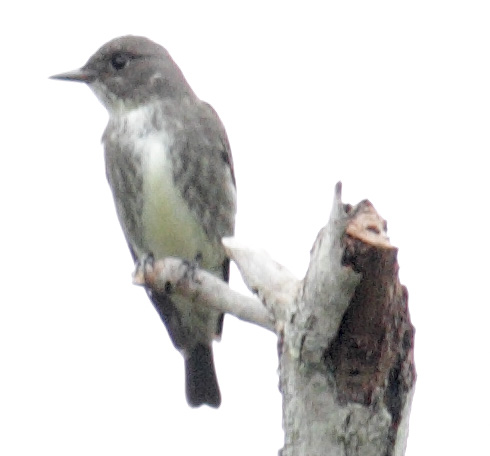
Olive-sided Flycatcher
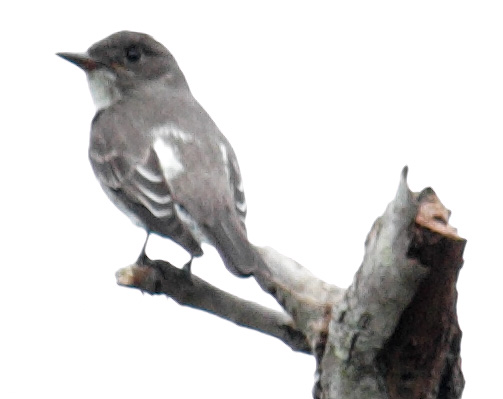
Olive-sided Flycatcher
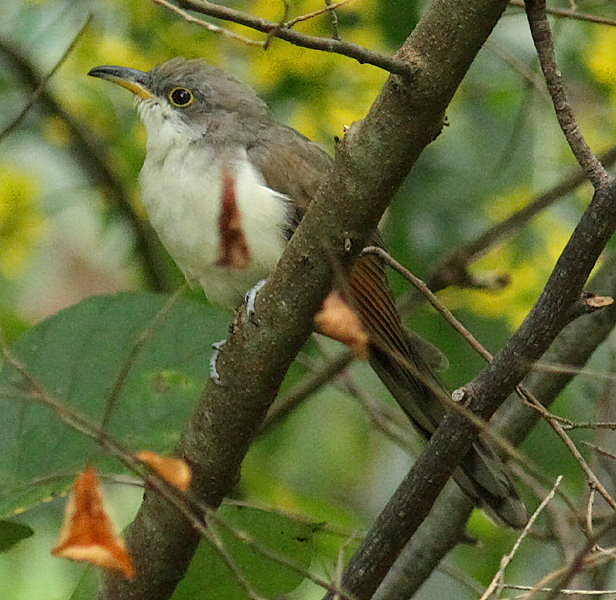
Yellow-billed Cuckoo
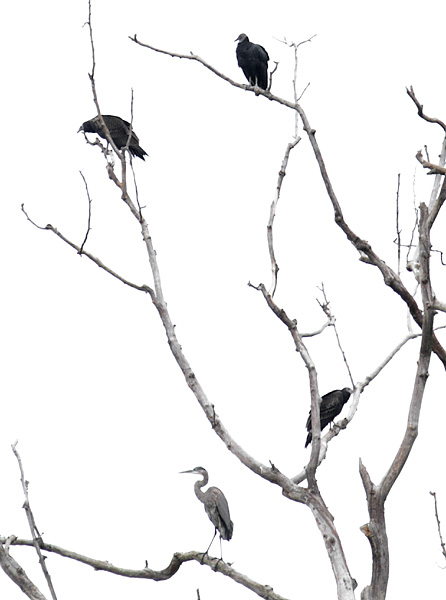
Great Blue Heron pretending to be a Black Vulture

Rose-breasted Grosbeak
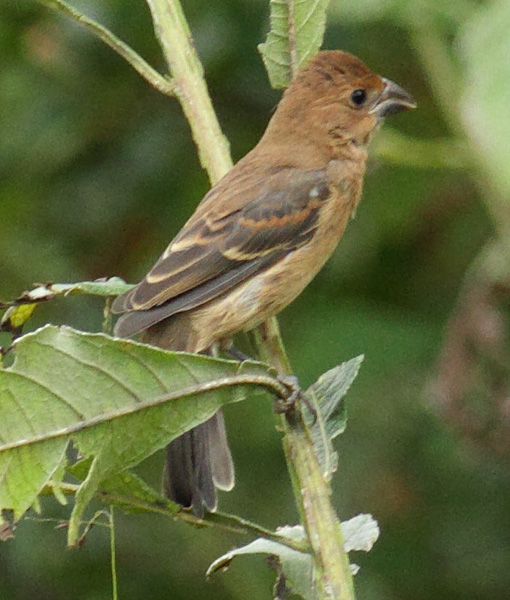
Blue Grosbeak
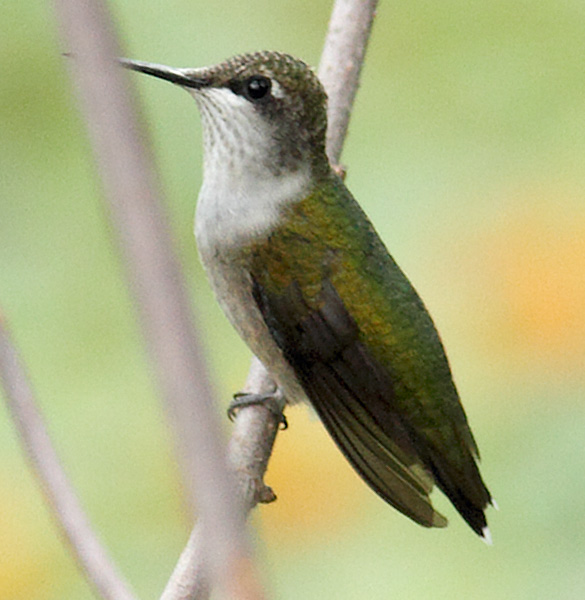
Ruby-throated Hummingbird

Northern Mockingbird
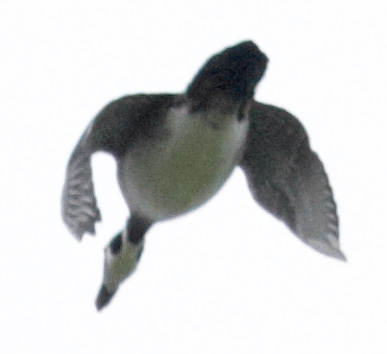
Wood Duck
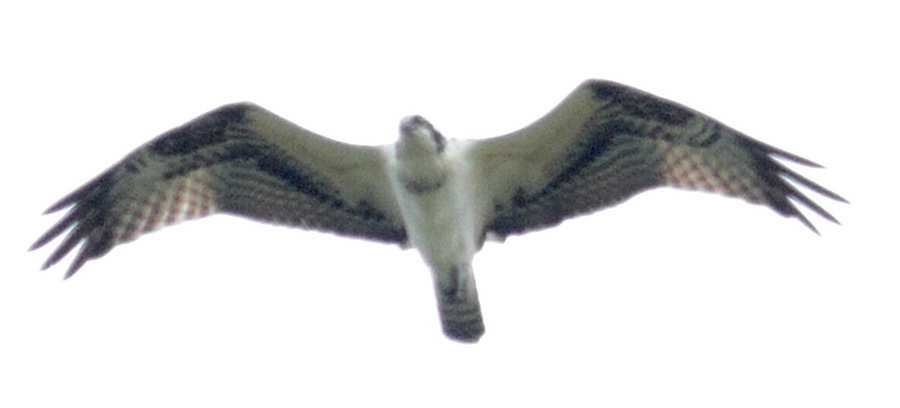
Osprey

Red-shouldered Hawk
Adding in species seen by Laubach and Mapel, and assuming that there were both Wilson's and Hooded Warblers on the Rockfish Valley Trail, the number of species seen on the trail during the past two weeks is now 77.
My morning's RV Trail list (50 species):
Carolina Wren House Wren Indigo Bunting Field Sparrow Chipping Sparrow Song Sparrow Eastern Towhee Red-shouldered Hawk Osprey Turkey Vulture Black Vulture Olive-sided Flycatcher Eastern Wood-Pewee Eastern Phoebe Ruby-throated Hummingbird Northern Cardinal Carolina Chickadee Rock Pigeon Pileated Woodpecker Red-bellied Woodpecker Downy Woodpecker Flicker Catbird Brown Thrasher Red-eyed Vireo White-eyed Vireo Scarlet Tanager Great Blue Heron Belted Kingfisher Blue Jay Wood Duck Cedar Waxwing Starling Rose-breasted Grosbeak Blue Grosbeak American Goldfinch Mourning Warbler Wilson's Warbler Hooded(?) Warbler Magnolia Warbler Chestnut-sided Warbler Nashville Warbler Black&White Warbler Palm Warbler Yellow-billed Cuckoo |